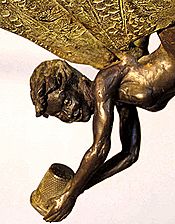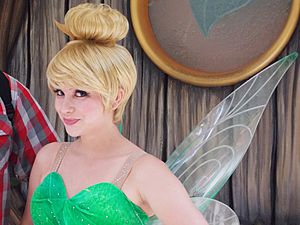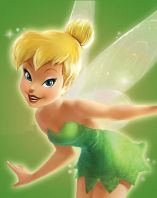Tinker Bell facts for kids
Quick facts for kids Tinker Bell |
|
|---|---|
| Peter Pan character | |

Tinker Bell (2005, bronze) by Diarmuid Byron O'Connor
|
|
| First appearance | Peter Pan (1904) |
| Created by | J. M. Barrie |
| Information | |
| Nickname(s) | Tink |
| Species | Fairy |
| Gender | Female |
| Occupation | Tinker fairy |
Tinker Bell is a fictional character from J. M. Barrie's 1904 play Peter Pan and its 1911 novelization Peter and Wendy. She has appeared in multiple film and television adaptations of the Peter Pan stories, in particular the 1953 animated Walt Disney picture Peter Pan. She also appears in the official sequel Peter Pan in Scarlet by Geraldine McCaughrean commissioned by Great Ormond Street Hospital as well as the "Peter and the Starcatchers" book series by Ridley Pearson and Dave Barry.
At first only a supporting character described by her creator as "a common fairy", her animated incarnation was a hit and has since become a widely recognized unofficial mascot of The Walt Disney Company, and the centrepiece of its Disney Fairies media franchise including the direct-to-DVD film series Tinker Bell and Walt Disney's Wonderful World of Color.
Contents
In original play and novel
Barrie described Tinker Bell as a fairy who mended pots and kettles, an actual tinker of the fairy folk. Her speech consists of the sounds of a tinkling bell, which is understandable only to those familiar with the language of the fairies.
Though sometimes ill-tempered, spoiled, jealous, vindictive and inquisitive, she is also helpful and kind to Peter. The extremes in her personality are explained in the story by the fact that a fairy's size prevents her from holding more than one feeling at a time, so when she is angry she has no counterbalancing compassion. Fairies can enable others to fly by sprinkling them with fairy dust (called "pixie dust" in the Disney films, and presented as "starstuff" in Dave Barry and Ridley Pearson's novel series). At the end of the novel, when Peter flies back to find an older Wendy, it is mentioned that Tinker Bell died in the year after Wendy and her brothers left Neverland, and Peter no longer remembers her.
On stage
In the original stage productions, Tinker Bell was represented on stage by a darting light "created by a small mirror held in the hand off-stage and reflecting a little circle of light from a powerful lamp" and her voice was "a collar of bells and two special ones that Barrie brought from Switzerland". However, a 'Jane (or Jenny) Wren' was listed among the cast on the programmes as playing Tinker Bell; this was a joke which also helped with the mystique of the fairy character, and fooled H.M. Inspector of Taxes, who sent Jane Wren a tax demand.
In the musical version of the play, she was also represented by a darting light, accompanied by a celesta.
In film
Film adaptations provided the first vocal effects for the character, whether through sound, such as musical expressions or the sound of a tinkling bell, or human speech.
Peter Pan (1924)
In the 1924 film, Tinker Bell was played by Virginia Browne Faire.
Peter Pan (1953) and other Disney media
In Walt Disney's 1953 film version of Peter Pan, the character is blonde, dressed entirely in green clothing, animated, and has no dialogue. As in the original play, Peter verbally interprets her communications for the sake of the audience, and bell noises are used when she makes gestures.
Tinker Bell has become one of Disney's most important branding icons for over half a century, and is generally known as "a symbol of 'the magic of Disney'". She has been featured in television commercials and programme opening credits sprinkling pixie dust with a wand in order to shower a magical feeling over various other Disney personalities, though the 1953 animated version of Tinker Bell never actually used a wand. In the picture and the official Disney Character Archives, she is referred to as a pixie.
There is a myth that the original animated version of Tinker Bell was modelled after Marilyn Monroe. However, Disney animator Marc Davis's reference was actress Margaret Kerry. He illustrated Tinker Bell as a young, attractive, blonde blue-eyed white female, with an exaggerated hourglass figure. She is clad in a short bright green dress with a rigid trim, and green slippers with white puffs. She is trailed by small amounts of pixie dust when she moves, and the dust can help humans fly if they think happy thoughts.
Since 1954, Tinker Bell has featured as a hostess for much of Disney's live-action television programming and in every Disney film advertisements flying over Disneyland with her magic wand and her fairy dust, beginning with Disneyland (which first introduced the theme park to the public while it was still under construction), to Walt Disney Presents, Walt Disney's Wonderful World of Color, and The Wonderful World of Disney. In 1988, she appeared in the final shot of the ending scene of Disney's Who Framed Roger Rabbit, along with Porky Pig; sprinkling fairy dust on the screen after Porky's trademark farewell as it goes black prior to the closing credits. She also starred alongside other Disney characters, such as Chip 'n Dale, in many Disney comics, where she was also able to speak. Tinker Bell also appears as a healing summon in the Kingdom Hearts series of video games and the card appearance in the video game Mickey's Memory Challenge on 1993.

At Disneyland, Tinker Bell is prominently featured in Peter Pan's Flight, a suspended dark ride based on the artwork from the animated film. Beginning in 1961, she was also featured as a live performer who flew through the sky suspended from a wire from the top of the Matterhorn Bobsled Ride at the beginning of the nightly fireworks displays. She was originally played by 71-year-old former circus performer Tiny Kline, up until her retirement three years later.
On the 2008 Walt Disney World Christmas Day Parade special on ABC, Disney announced that a Tinker Bell float would be added to the classic Disney's Electrical Parade at Disney California Adventure Park at the Disneyland Resort, the first new float to be added in decades.
Disney Fairies
Tinker Bell was the central character of the new Disney Fairies franchise, launched in 2005. In addition to an extensive line of merchandise, 2008's Tinker Bell film is the first of five direct-to-DVD features set in Pixie Hollow. Tinker Bell, who speaks in the Fairies universe, unlike her original appearances, is voiced by Mae Whitman in these digitally animated DVD features.
At Disneyland, a Pixie Hollow meet-and-greet area opened on October 28, 2008, near the Matterhorn, where guests are able to interact with Tinker Bell and her companions. A similar area called "Tinker Bell's Magical Nook" is in Adventureland at Walt Disney World's Magic Kingdom in Florida.
In November 2009, Tinker Bell became the smallest waxwork ever to be made at Madame Tussauds, measuring only five and a half inches.
On September 21, 2010, Tinker Bell was presented with the 2,418th star on the Hollywood Walk of Fame, becoming the thirteenth fictional character and the fifth Disney character to receive this honor. Tinker Bell's star celebrated Hollywood Walk of Fame's 50th anniversary.
Since 2012's Secret of the Wings, Tinker Bell is the first Disney fairy to have a sibling, a fraternal twin sister named Periwinkle, a frost fairy of the Winter Woods.
Hook
In the 1991 film Hook, Tinker Bell is portrayed by Julia Roberts. After taking the now-adult Peter to Neverland to rescue his children, Tinker Bell persuades Captain Hook to give her three days to restore Peter's lost memories (including his abilities to fly, fight, and crow) in order to ensure a fair fight between Peter and Hook. After Peter's memory is restored, Tinker Bell "wishes" herself into a human-size woman to share a kiss with Peter. After Peter returns to London, Tinker Bell appears to him one last time on the Peter Pan statue in Kensington Gardens to tell him that she will always love him.
In this version, Tinker Bell is portrayed as a winged, six-inch-tall tomboyish sprite with a red "pixie cut" hairstyle. She wears a ragged leather tunic with matching shorts and carries a dagger strapped to her leg. Only while flying does she appear as the traditional ball of light. Tinker Bell displays strength beyond all proportion to her size and is capable of picking up and carrying a grown man, as well as wielding a human sword while flying (giving the impression that the sword is hovering in mid-air). This is also the only interpretation in which Tinker Bell has the ability to transform into a human-size version of herself. Hook subverts Tinker Bell's canon by having her survive well into the modern era, whereas the original novel states that fairies are naturally short-lived and that Tinker Bell died a year after the Darling children's adventures.
Peter Pan (2003)
In the 2003 film Peter Pan P.J. Hogan originally planned to use a computer-generated version of the character, but instead used Ludivine Sagnier in combinations with digital models and effects to take advantage of the actress's expressions.
Peter Pan in Scarlet
Tinker Bell returns in the official sequel Peter Pan in Scarlet. When Wendy and the rest of the group reach Neverland and ask Peter where she is, he replies that he does not know anyone by the name Tinker Bell, which is explained as him not remembering her after she died. She is mentioned by Wendy and the rest of the Lost Boys to Fireflyer, a silly blue fairy, who when he reaches the top of Neverpeak, makes the wish to meet her. When they open Captain Hook's treasure chest, among other things, Tinker Bell is seen inside it to Fireflyer's joy. Initially, Tinker Bell does not like him, but eventually she comes to see that Fireflyer is not as bad as he seems to be. In the end, they get married and start selling dreams to the Roamers, previous Lost Boys that have been outcast by Peter, while having many adventures.
Peter and the Starcatchers
In Dave Barry and Ridley Pearson's Peter and the Starcatchers book series, Tinker Bell makes her first appearance at the end of the first novel. Originally, she was a green and yellow coloured bird who was put in a bag of starstuff, turning her into a fairy. Molly's father, the famous starcatcher Lord Leonard Aster, made her Peter's guardian and she follows him on all of his adventures. She doesn't like being called a fairy and would much rather be called "birdwoman" because of her origins. She is very protective of Peter, and hates his paying attention to any other female. She can be very impolite to others (only Peter is able to understand her perfectly, and most of the times does not reveal what she says about others, because it is mostly insults). She is also able to emit a very bright light, which she uses as an attack against other creatures, especially Lord Ombra, one of the main villains of the series.
See also
 In Spanish: Campanilla para niños
In Spanish: Campanilla para niños


